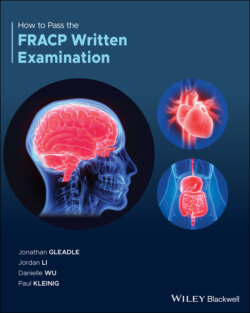Читать книгу How to Pass the FRACP Written Examination - Jonathan Gleadle - Страница 20
QUESTIONS (13–17) REFER TO THE FOLLOWING INFORMATION
ОглавлениеMatch each of the clinical scenarios with the best fitting dermatological emergency:
1 Drug rash with eosinophilia and systemic symptoms.
2 Meningococcaemia.
3 Necrotising fasciitis.
4 Disseminated candidiasis.
5 Staphylococcal scalded skin syndrome.
6 Stevens‐Johnson syndrome.
7 Acute generalised exanthematous pustulosis.
8 Toxic epidermal necrolysis.
1 13. A 21‐year‐old woman presents with a 6‐hour history of fever and rash over her body. She was started on oral trimethoprim for UTI 7 days ago. She takes no other medication and has no known allergies. On examination, she is febrile and other vital signs are in normal range. There are erythematous, urticarial, targetoid rashes studded with small, tense blisters on the shoulders, back, palms but less than 10% of body surface area involved. There are also small vesicles and crusts on the upper and lower lips, but there are no lesions are present on the soles or genitalia. Nikolsky’s sign is positive. Her FBE, LFTs, and renal function are normal.
2 14. A 25‐year‐old woman with a history of epilepsy, depression, and diabetes presents with fever (39oC ), a morbilliform eruption and facial swelling. Her GP had commenced her on paracetamol, carbamazepine and metformin 6 weeks ago. On examination, the rash has varying morphology with targetoid lesions, pustules and blisters, however she is Nikolsky sign negative. She has WCC of 16 × 109/L, eosinophil of 4 × 109/L, deranged LFTs and a serum creatinine of 300 μmol/L [45‐85]. The skin biopsy shows lichenoid infiltrate with focal necrotic keratinocytes.
3 15. A 58‐year‐old man presents with fever, malaise, and conjunctivitis progressing to a tender erythematous rash in the face, neck, axilla, and groin with mucous membranes spared. Nikolsky’s sign is positive and flaccid bullae develop in areas of erythema.
4 16. A 42‐year‐old woman presents with fever and examination showswidespread erythema worse on the skin folds progressing to widespread small coalescing pustules.
5 17. A 56‐year‐old man presents with a 3‐day history of worsening skin erythema, blistering and pain. He is known to have smoking related COPD. He was started with allopurinol 7 days ago, because of frequent acute gout attack. On examination, he is febrile, HR is 110 bpm, there is confluent erythema of the entire trunk and all extremities with blistering and erosions affecting >30% of the body surface. On palpation, mild pressure causes several non‐blistered skins to slough. There is mild neutrophilia, slight elevation in liver aminotransferase levels.
